The Business Continuity Imperative: Price and Revenue Management for Resilience in 2020 and Beyond
Economic dynamics and market pressures during a black-swan event can wreak havoc on efforts to effectively manage revenue operations and pricing for business continuity. For many organizations, environmental changes disrupt the methods by which these essential business processes are managed can be disrupted, damaging the revenue streams that create profitability. The array of pricing strategies and related promotional tactics across channels for configure, price and quote (CPQ), digital commerce and subscription management can challenge the best of organizations. Leadership must examine the agility of pricing management to determine if they have ability to make and manage changes to determine the effectiveness of decisions. This requires visibility into revenue operations and selling channels, which in turn requires programs, processes and technology designed to meet the needs of what is called price and revenue management (PRM).
Unfortunately, organizations far too often neglect the need for continuous pricing and revenue processes to ensure optimal business outcomes across financial and customer areas of operations. Therefore, Ventana Research asserts that through 2021, one-half of organizations will realize that digital transformation investments have not met the organizational readiness requirements of business continuity, leading to a new focus on innovative digital technologies that more reliably sustain operations.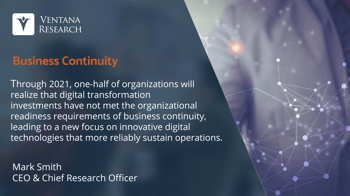
The business continuity imperative requires that organizations make it a priority to examine essential business and technology areas that are often overlooked in the physical and virtual workplace but that make a meaningful impact on financial objectives. Leadership must not just support business processes but ensure they’re optimized and that they support the level of resilience needed to weather internal and external factors that impact sustainability of operations. It’s critical to operate effectively — across direct channels to customers and indirect ones to partners — to provide products or services to the market.
Existing applications are not always designed to integrate pricing in a centralized and unified manner, which makes managing pricing across business processes more difficult than it should be. Whether your organization operates in a B2B or B2C manner, reaching optimal outcomes for effective price and revenue management requires a process that includes analytics, planning and modeling to best determine strategy. Easy digital participation and collaboration critical for anyone involved in the organization related to pricing and revenue management.
The most efficient approach requires methods that are easy to both assess and act upon to optimize results. Organizational sustainability hinges on effective technology investments that enable an enterprise to maximize its potential. So, where should leadership start?
Building Continuity with Pricing and Revenue Management
Every organization should start by holistically assessing all short- and long-term needs related to price and revenue management for business continuity that may already be in place. No matter how an organization manages its pricing to achieve agility and effectiveness in its readiness, to maintain business continuity it must remain on the lookout for the most successful and impactful pricing and promotional tactics. This is nearly impossible to accomplish from a tangle of spreadsheets and applications that do not provide the ability to manage and optimize pricing to revenue objectives.
Furthermore, organizations that haven’t yet unified pricing management across channels so that they’re managed in the cloud for continuous operations must make this an immediate priority. It’s difficult to maintain business continuity and achieve the optimization needed when pricing is not managed in a unified manner that ensures an acceptable level of resiliency.
Organizations should embrace a culture of seamless digital experiences that bolster more collaborative interactions across people, processes and systems for price and revenue management. Organizations that have a discipline for this imperative are well on their way to understand and optimize profitability. Streamlining pricing management is critical for success and this is impossible without high-quality digital experiences. In fact, Ventana Research asserts that by 2022, one-half of organizations will determine that the digital experiences they provide are not intelligent or automated and fall short in maintaining business continuity for organizational readiness, resulting in lost customers and workforce instability. Organizations must cultivate excellent experiences across all roles and people involved, using pricing processes, with applications and underlying data to build a strong, forward-looking and agile enterprise. 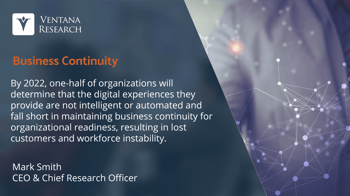
Success with business continuity must support more than just providing analytics on pricing changes or manage price lists with products and ensure that they are not inadequate or isolated within the individual applications across an organization. This approach can enable mistakes that collectively can impact revenue potential. Success is not even about pricing itself or sustaining those efforts in best and worst of times, under pressure and over time. Price and revenue management is about cultivating an enterprise-wise focus on margin optimization and profitability that enables the organization to seize market opportunities and deliver outcomes that exceed expectations.
Price and revenue management should go beyond optimizing these processes and operations — it should guide a path toward excellence in everything that the organization is focused on accomplishing. It should provide business insights using critical metrics from analytics that indicate the future revenue health of the organization as well as the readiness of those performing pricing strategies for margin optimization. This requires advanced techniques using machine learning (ML) and even further using artificial intelligence (AI) within a platform that integrates with specific applications for price and revenue management.
Managing revenue requires specialized analytics that can assess variables across pricing and promotions to optimize revenue across customer segments and market penetration strategies. Revenue analytics also should be able to provide historical performance and predictive indicators that leadership can then use to understand variances and target improvements. Many organizations depend on analytics but metrics that lack context or a dashboard-only approach are insufficient. The real value comes from applying machine learning and analytics to uncover challenges for optimizing margins and provide immediate guidance on revenue opportunities across the array of processes.
Machine-generated insights about pricing and revenue must be easy to manage and optimize; some of the most accessible insights use natural language and generate stories that can be read or heard, presenting the impact of potential plans in simple and actionable terms. A pricing and revenue management system should be able to create effective notifications that place intelligence into the hands of the people involved in the business process who are responsible for maximizing margins and customer relationships.
A pricing and revenue management system should be able to create effective notifications that place intelligence into the hands of the people involved in the business process who are responsible for maximizing margins and customer relationships.
I discussed this next generation of digital experiences in my recent perspective on how to use data and analytics to achieve organizational success. A strong focus on experiences can unify an organization’s efforts to not just sustain continuity but bring new value to business efforts through educating and guiding business professionals. It’s more about optimizing than administration of pricing. Optimizing margins is more than just a nicety; it’s essential for every organization that looks to make the most of customers relationships across channels of customers, partners and subscribers. Price and revenue management should be the foundation of all selling processes and experiences. I have written about this essential part of achieving sales performance.
Maintaining business continuity during challenging times means that an organization has the flexibility to adapt organizational priorities and rapidly align pricing and revenue plans to reach expected performance. This effort is important whether the work environment is from home or on the front lines of a pandemic; organizations should seek to manage towards bigger margins and better financial performance. Without an optimized and continuous set of processes dedicated to price and revenue management, an organization won’t be able to elevate performance and reach its ultimate potential; I recently discussed why this is a critical part of your mission for business continuity and beyond.
Digital Communications is Essential
Managing pricing requires not just the right platform and applications but ones that enable collaborative digital communications so leaders can make good decisions. Challenges such as a global pandemic or natural disasters demand digital communication across a distributed and most likely virtualized workforce; however, crises often shift priorities and engagement in price and revenue management can suffer.
Ventana Research asserts that through 2022, one-half of organizations will determine that their technology for unified communications is ineffective for meeting business continuity needs and falls short in the open communications requirements for secured and seamless interactions across devices and people. Organizations must ensure their digital communications can interoperate with the necessary applications and provide frictionless 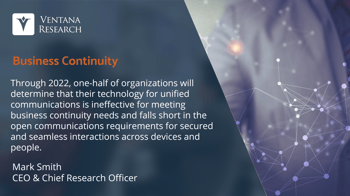 digital experiences and sensible pricing processes that ensure high levels of engagement. This collaboration might be best addressed through conversational computing methods such as intelligent virtual agents (IVAs), which are smarter than most bots. This technology should include AI so the organization can rapidly respond to individual needs and can also streamline responses to exceptions and issues that inevitably arise. IVA should enable a dialogue on pricing and revenue insights so stakeholders understand the full range of opportunities and potential challenges.
digital experiences and sensible pricing processes that ensure high levels of engagement. This collaboration might be best addressed through conversational computing methods such as intelligent virtual agents (IVAs), which are smarter than most bots. This technology should include AI so the organization can rapidly respond to individual needs and can also streamline responses to exceptions and issues that inevitably arise. IVA should enable a dialogue on pricing and revenue insights so stakeholders understand the full range of opportunities and potential challenges.
It’s important that an organization rally its digital communications efforts during a crisis such as a pandemic, because effectiveness in enhancing revenue across channels requires collaboration across the organization. To be effective, organizations should establish best practices and pricing policies that guide improvement to revenue processes, enhancing margins for profitability and financial performance. This assessment should include customers, partners and subscribers and should examine the extent to which contextual collaboration helps achieve mutual financial objectives. And organizations must keep this axiom of business continuity in mind: Applications and systems for price and revenue management must not just support digital communications; these tools should be a fundamental part of managing margins within the organization.
Pricing and Revenue Matters
Many organizations have managed the pricing processes that involve customers, marketing, operations, products, sales, subscribers and the demand chain across an array of business applications. However, few of these applications support a dedicated focus on optimizing pricing by providing an integrated and continuous toolset. A quality approach to managing pricing requires the right technology, which currently we certainly don’t find in spreadsheets, nor within ERP or CRM suites of applications. Many technology vendors have failed to provide an integrated and continuous approach to pricing and revenue management.
It’s important that an organization make investments in supporting price and revenue management that use an automated and intelligent approach — in other words, simplifying tasks, collaboration and facilitating easy examination of scenarios and potential outcomes. The current movement in technology towards a unified platform can satisfy these needs, optimizing pricing and enhancing operations across the organization. We assert that by 2022, one-third of sales organizations will determine that pricing of products and services is mismanaged and begin to invest in new pricing management software.  Success here demands using the right technology across the organization to provide visibility and optimization of pricing and revenue processes — in other words, the agility to adapt and improve in a volatile market climate.
Success here demands using the right technology across the organization to provide visibility and optimization of pricing and revenue processes — in other words, the agility to adapt and improve in a volatile market climate.
Organizations must improve pricing by assessing and prioritizing improvements to these processes to optimize engagement and readiness. Using the right technology is foundational to success and creates opportunities for breakthrough growth that far exceed mere productivity improvements. The work-from-home and virtualized business efforts during a pandemic are a prime example of how most organizations were ill-prepared because business continuity planning was not a priority. Many organizations do not have the ability to plan and adapt pricing to acceptable margins and achieve levels of revenue and profitability that meet financial performance expectations.
Sustainable growth requires a refined strategy on pricing and revenue management, which is only possible when an organization is deliberate about the technology it uses to work collaboratively across the organization to optimize growth, outcomes and ultimately revenue. Our research suggests that this need to collaborate will also require that organizations embrace more sophisticated forms of collaborative computing so that people across business processes can capture, share and analyze interactions to guide effective actions and decisions. For this reason, we assert that by 2023, one-half of organizations will shift from email to messaging-based collaboration; one-third of those also will adopt digital forums to capture knowledge and improve organizational competencies.
This requires an assessment of specific revenue strategies, particularly organizations engaged using configure, price and quote (CPQ) and digital commerce across B2B and B2C environments where customers and subscribers engage with products and services. Organizations with a unified approach to price and revenue management will find that it’s easier to achieve organizational agility with digital communication platforms that are open and secure and that can help increase the velocity of engaging in and executing on pricing strategies. For obvious reasons, price management technologies should integrate with product information management (PIM) and as I have articulated is a critical component of product experiences for buyers. Also, the use of augmented or extended reality is critical for buyers to simulate products and use of them. Thus configured products should be integrated with CPQ as well as dynamic pricing methods so leadership understands the revenue impact of configuration-based pricing.
Organizations should also prioritize investments that enable more effective price and revenue strategies and there enhanced organizational agility. Investments into dedicated applications with this focus are critical, especially during or following a pandemic, to ensure the continuity of processes. And clearly, organizations must be prepared to adapt and respond to business continuity priorities that can change daily. To do this organizations will need methods that use digital technology to virtualize interactions with technology that supports workflow and robotic process automation (RPA) to streamline and guide price- and revenue-related processes and workflows.
Smart Investments Matter
Organizations must consider whether investments in applications and technology support continuous optimization and visibility into pricing and revenue across all the channels. It’s also critical that investments are built from a cloud-based platform that can interoperate with the necessary people virtually and processes digitally while supporting operations in real-time. Supporting these processes is significantly different than traditional pricing methods, which need not necessarily be continuous and real-time. The right technology includes a platform and applications that easily integrate with the channels and portfolio or products and services across an organization and every line of business. Appropriate tools facilitate enterprise needs for a distributed — and during times of business continuity, virtualized — workforce and processes.
Investments should do more than manage prices or analyze potential revenue based on historical and projected sales but should provide value to everyone involved as well as support business continuity. And this is why we assert that through 2023, one-third of organizations will initiate business continuity planning to realign the priority of technology investments required to operate seamlessly in a distributed and virtual manner in customer, product, supply chain and workforce processes.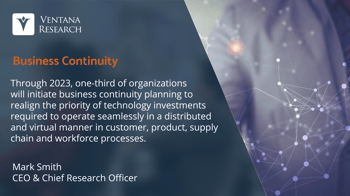
Smart investment requires an effective assessment of an array of applications and tools. A solid evaluation includes the following questions:
- Do your price management technologies support the feedback and optimization needed for your enterprise across types of buyers and channels of commerce?
- Do you have the price and revenue management processes to optimize margins and improve outcomes from existing and new customer relationships?
- Are you able to track and review pricing scenarios across channels of operations to those engaged in revenue processes during a pandemic?
- Are you able to optimize pricing and promotions across channels to gain immediate insight into needs and issues?
- Is your organization ready to manage engagement and measure how revenue strategies impact performance?
- Are you able to have digital communications across the revenue process and pricing used in the organization — and in a secured and governed manner?
- Can you integrate pricing across selling and across customers, partners and subscribers in a consistent manner that integrates across the organization?
- Do you have the analytics and predictive indicators for pricing and revenue insights that are dynamically generated from machine learning?
- Are you able to collaborate about pricing and revenue strategies across business process and garner structured feedback for optimizing margins?
A “no” answer to any of these questions indicates risk that could directly impact an organization’s potential with its price and revenue management efforts. Every organization — no matter the industry, the number of its employees or the size — has an opportunity to significantly improve its continuous revenue processes and provide pricing optimization across channels.
It’s critical that applications enable leaders and managers to adequately plan for and respond to needed changes in pricing and revenue strategies, from black-swan events to meeting typical business continuity obligations. Organizations are unwise to even consider any investments that aren’t analytics- and collaboration-ready. We assert that by 2022, one-third of organizations will determine that their business applications are not suited to support their business continuity needs due to ineffective collaborative and mobile experiences, which are essential to operate seamlessly in a virtual environment.
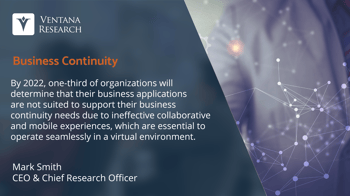 Every organization must ensure it has direct or embedded applications to operate across areas where products and services are sold and support remote management, including from the couch and home office, so it can effortlessly optimize pricing. Organizations should be ruthless about any operation that impedes this effort to meet pricing and margin requirements and ensure optimal levels of profitability. While organizations have spent significant resources and efforts on digital transformation in the form of automation and efficiency improvements, a far more important consideration is whether those investments make a meaningful impact on organizational agility and support a focus on revenue optimization so it can achieve best possible financial performance.
Every organization must ensure it has direct or embedded applications to operate across areas where products and services are sold and support remote management, including from the couch and home office, so it can effortlessly optimize pricing. Organizations should be ruthless about any operation that impedes this effort to meet pricing and margin requirements and ensure optimal levels of profitability. While organizations have spent significant resources and efforts on digital transformation in the form of automation and efficiency improvements, a far more important consideration is whether those investments make a meaningful impact on organizational agility and support a focus on revenue optimization so it can achieve best possible financial performance.
Partner with Business Leaders
The importance of teamwork among business leaders cannot be overstated when it comes to developing agility and engagement across the entire organization and its associated business processes that support price and revenue management. Pricing processes are typically focused on the customer, the optimization of which might be managed by the Chief Revenue Officer (CRO) and Chief Customer Officer (CCO). Those in this role are tasked with looking at the potential process and performance challenges and readiness of the organization to shift and meet revenue objectives. Smart leaders in business have developed models to assess any pricing and risk variables such as promotions and mix that can impact the organization’s ability to reach its financial objectives, including the critical objective of business continuity.
A successful price and revenue-focused organization goes further, embracing collaborative and continuous operations in all aspects of its business across customers, subscribers, partners, and selling channels, all of which contribute to the financial performance of the business.
A successful price and revenue-focused organization goes further, embracing collaborative and continuous operations in all aspects of its business across customers, subscribers, partners, and selling channels, all of which contribute to the financial performance of the business. A focus on price and revenue management is the foundation of both executive and operational leadership. However, cultivating excellent price and revenue management across the organization is just as important for ensuring business continuity. Thus, the Chief Revenue Officer’s (CRO) role is to work across the entire business to manage pricing and margins across channels. Ventana Research asserts that by 2025, more than half of B2B businesses will adopt price and revenue optimization. Today, the technology is only lightly adopted.
Enterprise leadership needs to work actively and closely with business process managers and examine how to engage and improve pricing. Success requires effective engagement, not just fulfilling and responding to the requests but operational efficiency. Similarly, legacy investments into traditional CRM and ERP or outdated pricing technology don’t provide sufficient organizational agility.
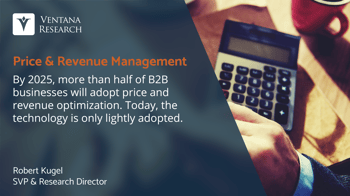
Unfortunately, business leaders might not always grasp their obligation to be a partner, but this can be addressed through executive dialogue on pricing and revenue management for business continuity to establish a clear understanding of the risks of not achieving expected outcomes. Business must lead and go beyond spreadsheets or stand-alone analytics tools to support their needs. One example is partnering across heads of finance, sales and operations to examine if pricing is optimized and effective. Dialogue across lines of business is a critical aspect of pricing effectiveness, and leaders must understand margins, channels and requirements to help business professionals work together to achieve optimal outcomes.
Technology vendors that provide price and revenue management tools have not done a great job marketing and selling their offerings beyond articulating how they help specific pricing audience segments or channels. Many of these vendors’ websites lack depth and connection to the range of lines of business and processes, thus needs often go unmet. Business leadership should treat this impediment as an opportunity to develop a common approach that unifies their efforts with a pricing and revenue platform and applications that optimize roles, the related processes and any constituents under a common objective of maximizing margins and customer relationships.
And of course, this effort should include price management software that helps model and benchmark all aspects of revenue, especially the ones that address the broader needs of specific roles and help establish a stronger connection with customers, partners and subscribers. Establish a baseline Pricing Index and apply analytical models and internal benchmarks to guide price improvements across specific channels for selling products and services. Solid benchmarks can help foster a path to building a business case for investment. Executive teams and even boards of directors are responsible for ensuring that investments into pricing and revenue processes will support current and future needs.
Next Steps
In times of crisis such as the current global health pandemic, when business continuity is a top priority, organizations mustn’t neglect digital investments into pricing and revenue management, especially if it has not previously been a focal point of executive leadership or a team involved with these processes. A superior approach demands technology that can improve processes, productivity and the overall digital effectiveness of pricing strategies to maximize revenue. Leadership that invests in managing pricing and related revenue processes can have a profound impact on business outcomes and an organization’s ability to reach expected levels of responsiveness and financial performance.
Ensuring optimal revenue strategies is a shared responsibility across the entire business and is impossible to do without leadership focused on optimizing pricing both inside and outside of the organization. Optimization is about more than just pricing software for recording policies. The right tools provide insights that can guide the effectiveness in revenue operations across the enterprise to meet business needs. It’s about a dedicated approach that’s focused on the pricing and revenue processes for an array of commerce and selling activities that span customers, subscribers and partners. Even a focus on experiences with prices related to products, via digital or physical, are part of the mission to experience management and should be swiftly addressed.
 Antiquated methods such as spreadsheets or stand-alone applications are not designed for managing pricing towards margin and volume targets and desired outcomes. We assert by 2023, competitive pressures will force three-fourths of B2B companies to adopt technology-supported strategic pricing strategies to achieve volume and margin objectives. Moreover, effective revenue management requires far more than just the administration and stand-alone, administrative tools certainly don’t provide modern digital methods to understand and optimize pricing. One-off technology approaches can also decrease productivity, diminish accountability and increase risk in not having a comprehensive enterprise-wide approach to price and revenue management. It is critical that organizations, especially in times of duress, use business continuity as a driver to engage the business through the intelligent use of dedicated pricing platform and tools, and thus should examine their investments in technologies.
Antiquated methods such as spreadsheets or stand-alone applications are not designed for managing pricing towards margin and volume targets and desired outcomes. We assert by 2023, competitive pressures will force three-fourths of B2B companies to adopt technology-supported strategic pricing strategies to achieve volume and margin objectives. Moreover, effective revenue management requires far more than just the administration and stand-alone, administrative tools certainly don’t provide modern digital methods to understand and optimize pricing. One-off technology approaches can also decrease productivity, diminish accountability and increase risk in not having a comprehensive enterprise-wide approach to price and revenue management. It is critical that organizations, especially in times of duress, use business continuity as a driver to engage the business through the intelligent use of dedicated pricing platform and tools, and thus should examine their investments in technologies.
If you are not sure how to approach improving the digital aspects of your business to better focus on the pricing and revenue — and thus engagement and outcomes — through the lens of business continuity, there are specific steps that every organization should take, similar to the steps outlined in my perspective on the imperative for digital innovation in business continuity. The effective use of digital technologies can reinvent pricing and revenue management — for every constituent no matter their role with the organization. This requires the right lens for a more comprehensive approach to support rather than distract from business continuity. Most organizations have realized this and are making it a priority to be more prepared. We assert that by 2022, after a decade of concerted efforts in digital transformation, one-half of organizations will not have established business continuity as an investment priority and will not be prepared to operate in a future pandemic or crisis, which will lead to increased operational risks.
To achieve business continuity, optimize underlying processes by embracing pricing management strategies that include dedicated selling applications that support CPQ, digital commerce and subscription management for business-wide efforts. This can have an immediate impact on top- and bottom-line results and reflects the priority you place on your business performance and revenue operations. Once your organization has an effective approach, you can be assured that your organization is built to last. Ensure that existing and future application investments are designed for effective price and revenue management, not just for automation and efficiency, but those that can integrate with PIM and customer relationship management (CRM) systems. The digital experience is much more than one application; it’s about tools that integrate pricing and revenue management across people, processes and an array of systems.
Every experience matters, including the internal ones. The entire executive team — the CEO’s staff, the CMO, CFO, CIO, CCO, COO, CXO, CPO, and the Chief Digital or Innovation Officers— should be aware of the strategy and plans for optimizing pricing. They should look to the CRO, who should be focused on optimizing pricing and revenue processes for future performance. Organizational leadership needs to ensure they embrace the discipline these efforts entail. The future depends on the active involvement of those who see building sustainable revenue as fundamental to business continuity and possess the agility and readiness to adapt and make smart changes.
Determining your path forward for 2020 and beyond requires an effective strategy that sustains business continuity and exceeds expectations. Make sure you are using applications and a pricing and revenue platform that can truly manage these crucial processes across channels to provide optimal margins, boost financial performance and enable sustainable long-term success.
Regards,
Mark
Authors:

Mark Smith
Partner, Head of Software Research
Mark Smith is the Partner, Head of Software Research at ISG and Ventana Research leading the global market agenda as a subject matter expert in digital business and enterprise software. Mark is a digital technology enthusiast using market research and insights to educate and inspire enterprises, software and service providers.









